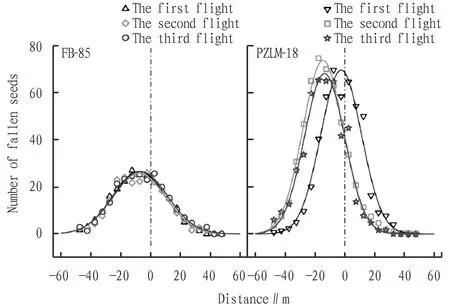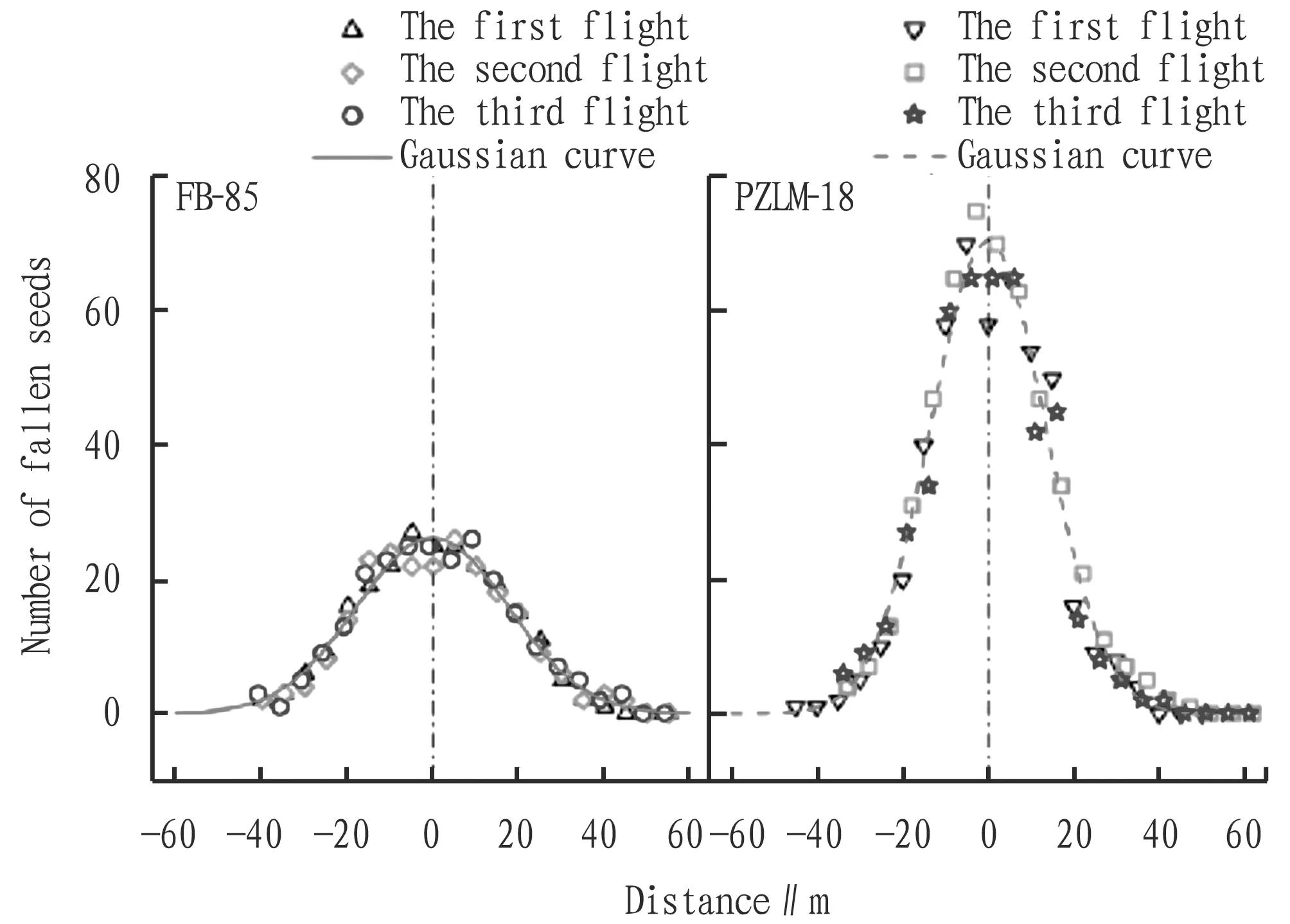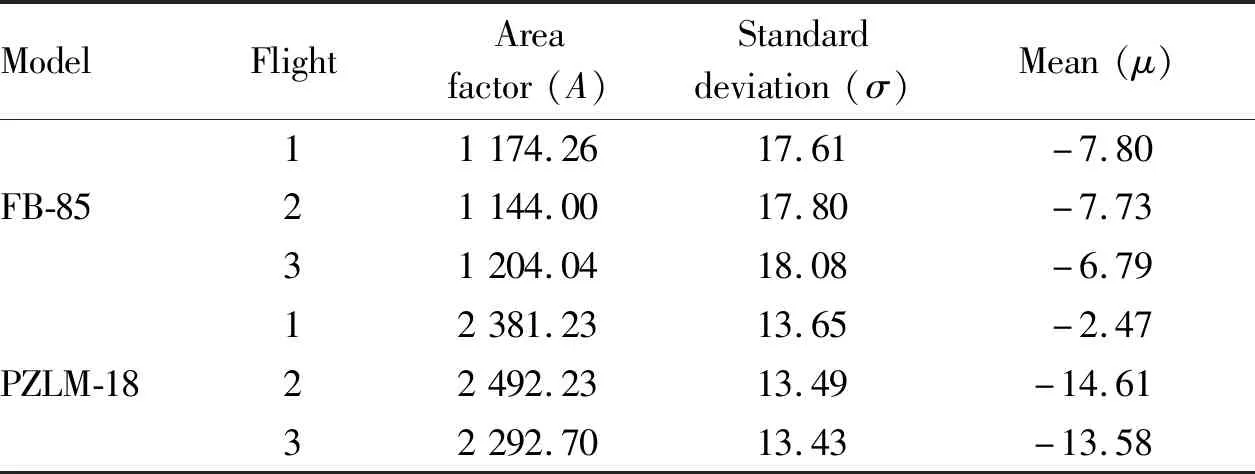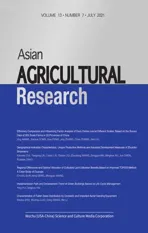Characteristics of Fallen Seed Distribution by Domestic and Imported Aerial Seeding Equipment
2021-09-24XiaoboZHUWuzhouLUOCongWANGBinLI
Xiaobo ZHU, Wuzhou LUO, Cong WANG, Bin LI
1. The Second Research Institute of the General Administration of Civil Aviation of China, Chengdu 610041, China; 2. Sichuan Tobacco Company of China National Tobacco Corporation, Chengdu 610041, China
Abstract In order to explore the seed drop characteristics by aerial seeding equipment, taking aerial seeding for Pinus tabulaeformis as an example, the Gaussian curve fitting and chi-square goodness-of-fit test were carried out on the data of fallen seed distribution, and the seed distribution models of domestic FB-85 and imported PZLM-18 equipment were established. The seeding performance indexes of the two kinds of equipment were calculated and compared by using the model, the existing problems of domestic equipment and their causes are analyzed, and finally, some suggestions for equipment optimization were put forward. The results indicated that the seed drop of the two kinds of equipment showed the characteristics of dense distribution in the middle and sparse distribution on both sides, and followed the Gaussian distribution as a whole; compared with PZLM-18, FB-85 had better seeding performance, but it also had the problem of uneven seed distribution; in addition to the influence of aircraft flow field, the fishtail structure design of diffuser is another important reason for the uneven seed distribution of domestic equipment; without changing the fishtail structure design, it is suggested that the principle of cross-superposition of two seeding belts should be used to replace a single large-size diffuser with two small-size diffusers, which can reduce the number of seeds in the middle and increase the number of seeds on both sides, so as to improve the uniformity of seed distribution.
Key words Aerial seeding equipment, Pinus tabulaeformis, Gaussian distribution, Chi-square test
1 Introduction
On March 4, 1956, the Chinese Air Force sowed about 1 500 kg ofPinus
massoniana
and Acacia confusa in Wuchuan, Guangdong Province, which officially opened the prelude to the aerial seeding for afforestation cause in China. Unfortunately, the first aerial seeding experiment ended in failure. In the following years, aerial seeding for afforestation in Shaanxi, Gansu, Qinghai and other places also had little effect. One of the main reasons for the unsatisfactory afforestation effect by aerial seeding is that aerial seeding, as a new afforestation method different from traditional artificial seeding, there was still a lack of understanding of the law of aerial seeding in China at that time. For this reason, many researchers have done a lot of targeted research on the law of aerial seeding. For example, Wu Qinxiaoet
al.
found that with the increase of flying altitude, a small number of seeds spread to both sides of the seeding area, but the change of the distribution pattern of falling seeds in the seeding area was not obvious by analyzing the distribution data ofPinus
tabulaeformis
under different altitude. Wang Shangwumade a linear fitting between the effective width of furrows for sowing and the average falling seed density ofP.
tabulaeformis
, and the results showed that they were highly negatively correlated. Many years’ experiments of Xing Xuexianget
al.
based on aerial seeding of small forage seeds such asAstragalus
adsurgens
revealed the functional relationship among width of furrows for sowing, flight height, wind speed and side wind angle. Liu Chunhuiet
al.
completed the simulation experiment of sowing rice (Oryza
sativa
) by the double-forked aerial seeding equipment in the laboratory, and explained the mechanism of seed movement in the equipment by using the theory of gas-solid two-phase flow. These applications and theoretical studies provide a reference for the formulation of the optimal operation parameters of aerial seeding and the research and development of domestic equipment, and promote the steady improvement of the afforestation level and effect of aerial seeding in our country. However, the previous research work has not carried out in-depth analysis on the falling seed distribution characteristics by domestic aerial seeding equipment, so that the seeding performance of domestic equipment can not be evaluated accurately and objectively, which is not conducive to finding and solving the problems existing in the equipment itself. Furthermore, it is difficult to give full play to the advantages and potential of aerial seeding for afforestation. TakingP.
tabulaeformis
as an example, this paper establishes the seed distribution model of typical aerial seeding equipment at home and abroad, evaluates their seeding performance, and puts forward some suggestions for the optimization of domestic equipment, which is of great significance to improving the quality of aerial seeding operation.2 Materials and methods
The two kinds of aerial seeding equipment compared in this paper belong to the pneumatic type. Compared with the centrifugal aerial seeding equipment, the pneumatic equipment has simpler structure, lower seed injury rate and higher seeding efficiency. FB-85 aerial seeding equipment is a kind of airborne operation equipment independently developed in China, and widely used in the field of aerial seeding for afforestation in China. The PZLM-18 aerial seeding equipment made in Poland is similar to FB-85 in seeding principle and appearance structure, and it is exported to many countries in Europe and the Americas.
P.
tabulaeformis
is one of the three main tree species for aerial seeding for afforestation in China, and has the characteristics of strong adaptability, fast water absorption and good seedling establishment effect. This tree species has been sown in a large area in many provinces represented by Hebei, and remarkable ecological and economic benefits have been obtained. The seed distribution data ofP.
tabulaeformis
used in this paper come from the test report of spreading quality of aerial seeding equipment compiled by the Second Research Institute of the General Administration of Civil Aviation of China. The testers carried out three flights forP.
tabulaeformis
seeding test on the above two kinds of aerial seeding equipment. There were three parallel sampling lines in each flight, the direction of the sampling line was perpendicular to the flight direction, and 20 sample plots were arranged on each sampling line, with an interval of 5 m between the adjacent sample plots. After each seeding, the number of seeds falling in each sample plot was counted. The operating altitude was 100 m, the seeding rate was 7.5 kg/ha, the designed width of furrows for sowing was 50 m, and the designed seed density was 20 seeds/m.The data processing methods involved in this paper mainly include the following three kinds:
(i) The curve fitting was carried out onP.
tabulaeformis
seed distribution data by using Gaussian function (formula 1), and the model ofP.
tabulaeformis
seed distribution without crosswind was established after data correction.
(1)
wherey
is the number of fallen seeds ofP.
tabulaeformis
per square meter,x
is the distance,A
is the area coefficient and its size is the area surrounded by the Gaussian fitting curve and the straight line (y
=0),σ
is the standard deviation, andμ
is the mean.(ii) Chi-square test was used to test the goodness of fit. Through formula (2) and formula (3), the chi-square valueχ
can be obtained, and then according to the degree of freedomdf
, it is easy to know the goodness-of-fitp
by looking up inχ
distribution table. The closer thep
is to 1, the better the goodness of curve fitting is.
(2)

(3)
wheref
andnp
are the measured and expected frequency, respectively, that is, the measured and theoretical values of the number of fallenP.
tabulaeformis
seeds per square meter in intervali
,n
is the cumulative value of the measured frequency in each interval,p
is the probability of seeds falling into intervali
,A
is the area surrounded by a Gaussian fitting curve and a straight line (y
=0) in the intervali
.(iii) Through the seed drop model ofP.
tabulaeformis
, the seeding performance indexes of two kinds of aerial seeding equipment were calculated, such as full width of furrows for sowing, effective width of furrows for sowing, maximum seed density, average seed density, and seed evenness. The effective width of furrows for sowing refers to the seeding width with 4 seeds per mor more.. The average seed density refers to the number of fallen seeds per unit area under effective width of furrows for sowing. The seed evenness is expressed by the coefficient of variation of average fallen seed density. The smaller the coefficient of variation is, the better the uniformity of fallen seeds is.3 Results and analysis
3.1 Gaussian curve fitting
Fig.1 shows the fallen seed distribution ofP.
tabulaeformis
by FB-85 and PZLM-18 aerial seeding equipment. It can be seen that the number of fallenP.
tabulaeformis
seeds per square meter by the two kinds of equipment showed the distribution characteristics of being dense in the middle and sparse on both sides, and the seed distribution data was close to the Gaussian distribution. The parameters of the Gaussian fitting curve are shown in Table 1. At the same time, it was found that the seed position deviated from the side of the flight direction as a whole, which was due to the crosswind in the process of seed falling. The distance between the symmetry axis (x
=μ
) of the Gaussian fitting curve and the vertical dotted line (x
=0) in Fig.1-2 is the seed deviation distance, which is the absolute value of the parameterμ
in Table 1. There were differences in the fallen seed deviation distance between the three flights for the same equipment, especially for PZLM-18, the fallen seed deviation distance in the first flight was 10 m more than that in the other two flights. Studies at home and abroad show that the larger the crosswind speed and crosswind angle, the greater the deviation distance.
Fig.1 Distribution of fallen Pinus tabulaeformis seeds (before revision)
In order to eliminate the influence of crosswind, the seed distribution data ofP.
tabulaeformis
for the two kinds of equipment in different flights were modified one by one. Taking the first flight data of FB-85 as an example, the whole data was moved 7.8 m to the right, and the moving distance was the absolute value of the parameterμ
corresponding to the flight in Table 1. The modified seed distribution ofP.
tabulaeformis
is shown in Fig.2. For the same equipment, there was no significant difference in the modified seed distribution data for three flights, so the whole Gaussian curve fitting was carried out for the data of three flights. Formula (4) and formula (5) are the Gaussian fitting curve equation of FB-85 and PZLM-18 aerial seeding equipment in Fig.2, respectively, that is, the seed distribution model ofP.
tabulaeformis
:
Fig.2 Distribution of fallen Pinus tabulaeformis seeds (after revision)

Table 1 Parameters of Gaussian fitting curve

(4)

(5)
3.2 Goodness-of-fit test
In order to verify the coincidence degree between the distribution model and the actual data, the chi-square goodness-of-fit test was carried out. According to the calculated values of measured frequency and expected frequency of the two types of equipment (Table 2 and Table 3), they are substituted into the formula (2), and it is easy to know that the chi-square values (χ
) of FB-85 and PZLM-18 aerial seeding equipment are 11.96 and 11.84, respectively, and the degrees of freedom df are 17 and 15, respectively. According to theχ
distribution table, the goodness of fit p was 0.80 and 0.69, higher than the significance level of 0.05, which showed that theP.
tabulaeformis
seed distribution model for the two kinds of equipment was in good agreement with the actual fallen seed distribution data.
Table 2 The measured frequency and expected frequency (FB-85)

Table 3 The measured frequency and expected frequency (PZLM-18)
3.3 Comparison of seeding performance
Table 4 showed the calculated values of seeding performance indexes such as full width of furrows for sowing, effective width of furrows for sowing, maximum seed density, average seed density, and seed uniformity. Under the condition of flying altitude of 100 m and seeding rate of 7.5 kg/ha, the full and effective width of furrows for sowing ofP.
tabulaeformis
by the two kinds of equipment was larger than the designed width of furrows for sowing (50 m), and the full and effective width of furrows for sowing is greater for FB-85, 13.3% and 8.6% higher than that for PZLM-18.
Table 4 Seeding performance index of Pinus tabulaeformis
The fallen seed density of PZLM-18 was higher, and the maximum seed density and average seed density for PZLM-18 were 70 seeds/mand 35 seeds/m, respectively, 2.7 and 2.2 times of those for FB-85, but the seed uniformity of PZLM-18 was poor. It can be seen from Fig.2 that the distribution curve of fallen seed is "thin and high", and the seed is too concentrated in the middle of the effective width of furrows for sowing, and there is a great difference between the middle peak value and the seed density on both sides, and the ratio between them is 35∶2. This will lead to overdense localP.
tabulaeformis
stand and increase the workload and cost of tending and thinning in the later stage. Another disadvantage is that once the crosswind is strong during the seeding operation, it is very easy to cause repeated seeding or missed seeding, so the effect of aerial seeding for afforestation will be greatly reduced.It is worth mentioning that within the effective width of furrows for sowing of 70 m, the average seed density of FB-85 (16 seeds/m) was slightly lower than the designed seed density (20 seeds/m). Within the designed width of furrows for sowing of 50 m, the average seed density of FB-85 was 18 seeds/m, which was close to the designed value. Xing Xuexianget
al.
pointed out that there was a phenomenon of bouncing and rolling after the seeds sown by aircraft hit the ground, so that the number of fallen seeds in the sample plot was smaller than the actual number of fallen seeds. Therefore, it is reasonable to think that the actual average fallen seed density of FB-85 can reach 20 seeds/mwithin the designed width of furrows for sowing of 50 m. According to the comprehensive comparison of various seeding performance indexes, theP.
tabulaeformis
seeding performance of seeding equipment FB-85 is better than that of PZLM-18.4 Conclusion and discussion
In this paper, according to the fallen seed distribution and chi-square goodness-of-fit test, it is confirmed for the first time that the fallen seed distribution ofP.
tabulaeformis
by both domestic FB-85 and imported PZLM-18 aerial seeding equipment follows Gaussian distribution. The method used in this paper to establish the seed drop model ofP.
tabulaeformis
can be extended and applied to other types of seeds (see referencefor fallen seed distribution data), and it is found that the seeds of other plant types such asP.
massoniana
,A.
adsurgens
and rice also follow Gaussian distribution after aerial seeding. Different types of seeds have different size, shape and stress state, and different falling trajectories will be formed after aerial seeding, which will eventually affect the number of fallen seeds in different positions within the width of furrows for sowing. In spite of this, the seed distribution of different seeds still follows the Gaussian distribution, but the corresponding Gaussian fitting curve shape will be different. The above analysis shows that whether it is domestic or imported pneumatic aerial seeding equipment, different types of seeds show typical Gaussian distribution characteristics after spreading.By comparing the seeding performance index ofP.
tabulaeformis
for two kinds of aerial seeding equipment, it is true that the seeding performance of FB-85 is relatively better. But objectively, the domestic equipment also has the problem of uneven seed distribution, and the fallen seed density in the middle of the effective width of furrows for sowing is 6.5 times that on both sides, that is to say, if 2 seeds fall on the edge, 13 seeds will fall in the middle. Wu Qinxiaoet
al.
weighed and dissected the seeds ofP.
tabulaeformis
within the width of furrows for sowing, and found that there was no significant difference in the weight and quality of the seeds in different positions within the width of furrows for sowing, indicating that the seed itself was not the cause of uneven seed distribution. From the point of view of aerodynamics, Liu Chunhuiet
al.
considered that the propeller flow, fuselage vortex and wingtip tail vortex of fixed-wing aircraft interfered with the falling trajectory of seeds, resulting in dense seed distribution in the middle and sparse distribution on both sides. In addition, the uneven distribution of falling seeds is also closely related to the structural design of seeding equipment. The FB-85 diffuser is shaped like a fish tail and has nine unevenly spaced channels inside. Bansalet
al.
conducted finite element modeling on a kind of similar pneumatic aerial seeding equipment, and performed a simulation calculation on the time of seeds passing through different lengths of flow channels. The results showed that the shorter the flow channels, the shorter the time for seeds to pass through the flow channels. In view of this, it is known that the number of seeds ejected from the flow channel is inversely proportional to the length of the flow channel in the same period of time, so the shortest middle flow channels of FB-85 eject the largest number of seeds; the longest flow channels on both sides eject the least number of seeds. The joint action of the above external factors (aircraft flow field) and internal factors (seeding equipment structure design) aggravates the problem of uneven distribution of seeds.The ideas to solve this problem are as follows: one is to improve the aerodynamic shape of the aircraft, and the other is to improve the diffuser of the seeding equipment. Obviously, the former is more difficult, longer and more expensive, so the second way of thinking should be adopted. The aerial seeding equipment developed by the University of Auckland in New Zealand can sow three strands of seeds at the same time, forming three intersecting fallen seed zones, and the overall seed drop curve is flat, which effectively improves the fallen seed uniformity. The R&D unit of FB-85 aerial seeding equipment can learn from the superposition pattern of multiple fallen seed belts and try to replace the original large-size diffuser with two small diffusers. In theory, it can reduce the number of fallen seeds in the middle and increase the number of fallen seeds on both sides, so as to make the seed distribution more uniform. After preliminary calculation, the coefficient of variation of the average fallen seed density after the improvement decreased from 47.6% to less than 30%, and the fallen seed uniformity has been substantially improved. In the next step, the improvement and experimental verification of the diffuser of FB-85 aerial seeding equipment will be carried out jointly with domestic equipment R&D units. By optimizing the performance of domestic aerial seeding equipment, the afforestation level and effect by aerial seeding in China will usher in another round of new leaps in the future.
杂志排行
Asian Agricultural Research的其它文章
- Efficiency Comparison and Influencing Factor Analysis of Dairy Farms over/at Different Scales: Based on the Survey Data of 263 Scale Farms in 22 Provinces of China
- Regional Differences and Optimal Allocation of Cultivated Land Utilization Benefits Based on Improved TOPSIS Method: A Case Study of Guangxi
- Thoughts on Present Situation of Development of Rural Animal Husbandry and Its Relationship with Construction of Ecological Agriculture and Revitalization of Rural Industry
- Implementation Path and Development Trend of Green Buildings Based on Life Cycle Management
- Hot Spot Analysis and Development Trend of Intelligent Roof Parking Lot: Bibliometric Analysis Based on CiteSpace Visualization Software
- Biological Evaluation of Water Quality for Benthos in Typical Rivers of Eastern Jilin Province
